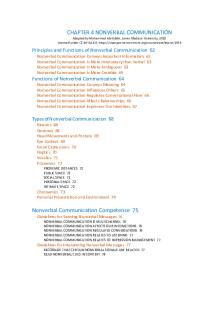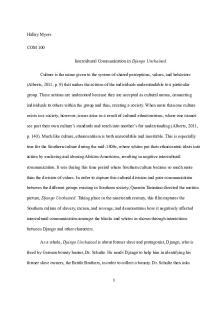Chapter 4 - Identity and Intercultural Communication - Summary Form PDF

| Title | Chapter 4 - Identity and Intercultural Communication - Summary Form |
|---|---|
| Course | Intercultural Communication |
| Institution | Sam Houston State University |
| Pages | 3 |
| File Size | 84.6 KB |
| File Type | |
| Total Downloads | 71 |
| Total Views | 153 |
Summary
Summary of Chapter 4 from "Experiencing Intercultural Communication: an Introduction"...
Description
COMS3370:I nt er cul t ur alCommuni cat i on
Chapter 4 Summary Form
1. What are the major theories and/or topics discussed in the chapter? (2 pt.)
Understanding the concept of identity Development of identity through individuals’ interactive processes, such as communication. Understanding the significance of social and cultural identities Various ways in which people communicate their identities Development of identities in a multicultural society Multicultural people and identity development The effect of language on identity development
2. Who are the representative theorists discussed in the chapter? (1 pt.)
Rudi Bleys- multicultural sexualities researcher Jeffrey Arnett- a scholar who introduced the development of “emerging adulthood” to explore peoples’ behaviors at their 20s. Csanad Szegedi- a religious identity scholar known for anti-Semitic remarks. Justin Trudeau- the Canadian Prime Minister, explores the meaning of Canadian identity. Kenneth J. Gergen, a psychologist, explains the challenges of identity through communication Caitlyn Jenner and Laverne Cox demonstrate that identities are dynamic
3. What are the key claims discussed in the chapter? (6 pts.) In Chapter four, the author explores some significant concepts of identity in an intercultural communication. The reading claims that the identification process is not ‘smooth’ since an individual can only identify himself or herself by communicating with others. Besides, identities are dynamic and multiple because they can develop in various ways in different societies. However, anytime the created identities conflict with an individual’s perception of his or her origin, there is a need to renegotiate them through social resistance. The author explores the challenges of living on the border between particular cultures. The discussion is facilitated with the following sub-topics: Understanding identity, social and cultural identities, identity development, and multicultural identity. Understanding identity explores various ways people create the perception of themselves and others. In this case, the author argues that identities are developed through communication and in spurts. The statement means that individuals have to interact with other people to identify themselves in a particular society. The Canadian Prime Minister, Justin Trudeau, maintains that Canadians’ identity is not defined with color or language. The leader recognizes that identities are multiple, and largely influenced by the society. For example, a student or a couple can change
YourName COMS3370:I nt er c ul t ur alCommuni cat i on
Chapt er4 Dat e
his or her identity due to social influence. The claim leads to an assertion that identities are created in several ways in various cultures. Therefore, Kenneth Gergen maintains that multicultural interaction greatly influences people’s beliefs. The claim supports the idea that identities are dynamic and multiple. For example, the way people viewed women in the early centuries has changed. In the contemporary world, gender does not play a significant role in professions. At the same time, identities are viewed multiple since individuals associate themselves with particular groups within a society. The practice is mainly common among feminists. Overall, understanding one’s identity is not easy since the process requires assertive social interaction in a multicultural setting. Social and cultural identities explore the impact of beliefs on the sexuality, age, race, religion, class, nationality, and personal identity. In this section, the author explains the relationship between people’s traditions and the mentioned social factors. For instance, age is an important aspect of life in many cultures. Therefore, the society has some expectations on how people should behave according to their age. The same beliefs reflect sexuality, nationality, and class identity. In most Western countries, women are expected to be tall and thin like Nicole Richie, a famous actress. On the other hand, east Africans do not consider the ‘model-like’ bodies attractive. Class identity is mainly experienced among the rich, who associate the taste and preference of their counterparts as ‘out fashioned.’ The perception shapes one’s racial and national identity. Some people are ashamed of their ethnic groups due to stereotyping based on factors, such as religion and physical capability. Csanad Szegedi is one of the scholars who prejudiced individuals due to their religious beliefs. He had strong anti-Semitic remarks during his political career. Nonetheless, a person can feel comfortable after socializing with people from different backgrounds and accepts the significance of diversity. Identity development depends on people’s background in a given society. The author explores the relationship between the minority and majority groups in the United States. The analysis suggests that minority groups have a stronger attachment to racial and ethnic issues compared to the majorities. The country has experienced various racial based conflicts, which criticize police brutality against the black Americans. One of the recent demonstrations with a slogan “black lives matters” exposed identity development among the minority group. Besides, the election of President Barack Obama boosted the pride of Africans across the world. The identity development involves the characteristics of Whiteness. According to the reading, the minority group believes that Whites have special privileges at the expense of blacks. Nonetheless, the author notes that identity development based on prejudice against a particular group is not healthy for intercultural communication. Multicultural identity arises when one has interacted with people from various backgrounds. The author defines such individuals as “multicultural people” since they can easily associate with diverse cultural identities. The explanation uses President Barack Obama as an example of ‘global nomads’ because he was raised in different locations with diverse traditions. As a result, many believe that he can adapt and socialize well with diverse identities. However, the author admits that living ‘On the Border’ is one of the most difficult challenges in social life because the aspect is associated with culture shock. Therefore, most people feel uncomfortable in strange environments.
COMS3370:I nt e r cul t ur alCommuni cat i on
4. What are some interesting applications of the theories/topics/key claims that are discussed in the chapter? For example, how can the ideas from this chapter be applied to your own life? (3 pts.) Identity is one of the most significant aspects of intercultural communication. The chapter explores essential information which can be applied in the contemporary interactions. For instance, the author teaches us the importance of rational identity development. I can apply the lesson to appreciate the role of diversity in multicultural interaction. There is no need to stereotype my colleagues based on social, religious and political factors. Consequently, I will advise my friend to stop viewing whites as social oppressors. Instead, I will inform him to contemplate all situations involving racial identity conflicts to avoid making irrational conclusions. Besides, the chapter has boosted my pride as a member of a minority group. Therefore, I do need to develop irrational perceptions of the Whites’ characteristics. I now believe that everyone has a responsibility, which should be met by rational actions. Overall, I will apply the teachings of this chapter to avoid negative influence from the society and become one of the multicultural people. 5. Think of a pop culture reference to the theories/topics/key claims that are discussed in the chapter. What song, movie, TV shows, etc. can be applied to illustrate the ideas from the chapter? (3 pts.) Although the chapter can be applied in all aspects of social dimension, I think it would be interesting to apply it in foster homes. Throughout the reading, I connected one of the famous TV series, The Fosters (2003), with the various ways of identity development. The show reflected the plight of children, in a foster home, who lacked a specific identity. One of the characters, Mariana, was never proud of his Mexican origin. Therefore, she once dyed her hair to associate with whites. On the other hand, Callie Jacobs feared to fall in love with Brandon due to social class conflict. Sexual identity features the owners of the Foster homes since they are gays. Nonetheless, how should Callie and her brother create an identity when they know little about their backgrounds? Is it right to abandon biological parents and identify with the foster parents? I am sure thisS will lead to an exciting study....
Similar Free PDFs

INTERCULTURAL COMMUNICATION in Contexts
- 560 Pages

Communication Theory of Identity
- 4 Pages

Chapter 4 Nonverbal Communication
- 19 Pages

Communication and docs Chapter 4 emt
- 15 Pages
Popular Institutions
- Tinajero National High School - Annex
- Politeknik Caltex Riau
- Yokohama City University
- SGT University
- University of Al-Qadisiyah
- Divine Word College of Vigan
- Techniek College Rotterdam
- Universidade de Santiago
- Universiti Teknologi MARA Cawangan Johor Kampus Pasir Gudang
- Poltekkes Kemenkes Yogyakarta
- Baguio City National High School
- Colegio san marcos
- preparatoria uno
- Centro de Bachillerato Tecnológico Industrial y de Servicios No. 107
- Dalian Maritime University
- Quang Trung Secondary School
- Colegio Tecnológico en Informática
- Corporación Regional de Educación Superior
- Grupo CEDVA
- Dar Al Uloom University
- Centro de Estudios Preuniversitarios de la Universidad Nacional de Ingeniería
- 上智大学
- Aakash International School, Nuna Majara
- San Felipe Neri Catholic School
- Kang Chiao International School - New Taipei City
- Misamis Occidental National High School
- Institución Educativa Escuela Normal Juan Ladrilleros
- Kolehiyo ng Pantukan
- Batanes State College
- Instituto Continental
- Sekolah Menengah Kejuruan Kesehatan Kaltara (Tarakan)
- Colegio de La Inmaculada Concepcion - Cebu











